Why Interior Designers differ from Architects in their use of colours in interior
VerifiedAdded on 2023/01/23
|7
|1641
|60
AI Summary
This article discusses the differences between architects and interior designers in their use of colours in interior design. Architects tend to focus on space, texture, and form, while interior designers have a deep understanding of colours and their psychological effects. The article explores the reasons why architects avoid using colours and how interior designers use colours to shape and enhance a space. It also highlights the importance of colours in creating the desired atmosphere and perception of a space.
Contribute Materials
Your contribution can guide someone’s learning journey. Share your
documents today.
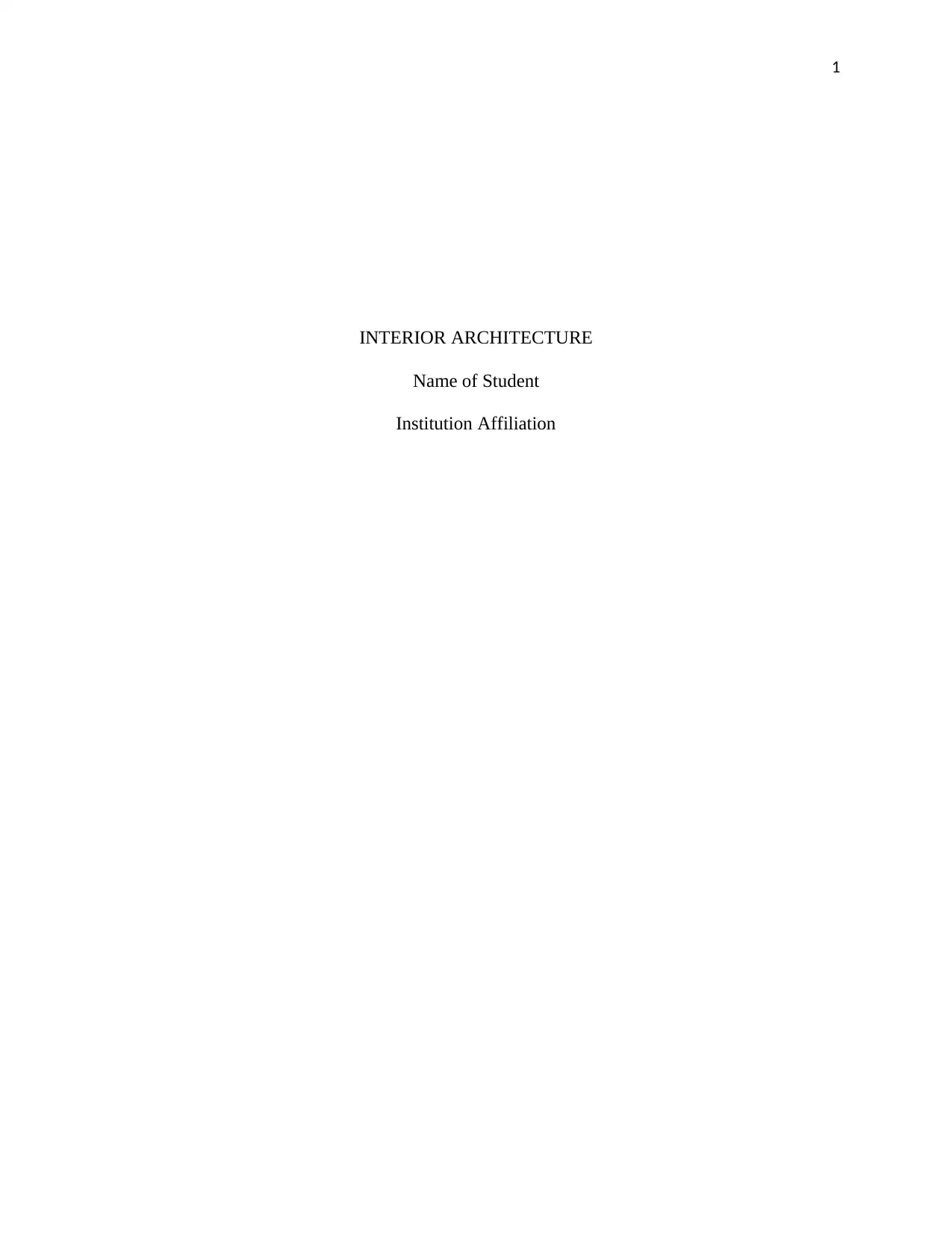
1
INTERIOR ARCHITECTURE
Name of Student
Institution Affiliation
INTERIOR ARCHITECTURE
Name of Student
Institution Affiliation
Secure Best Marks with AI Grader
Need help grading? Try our AI Grader for instant feedback on your assignments.
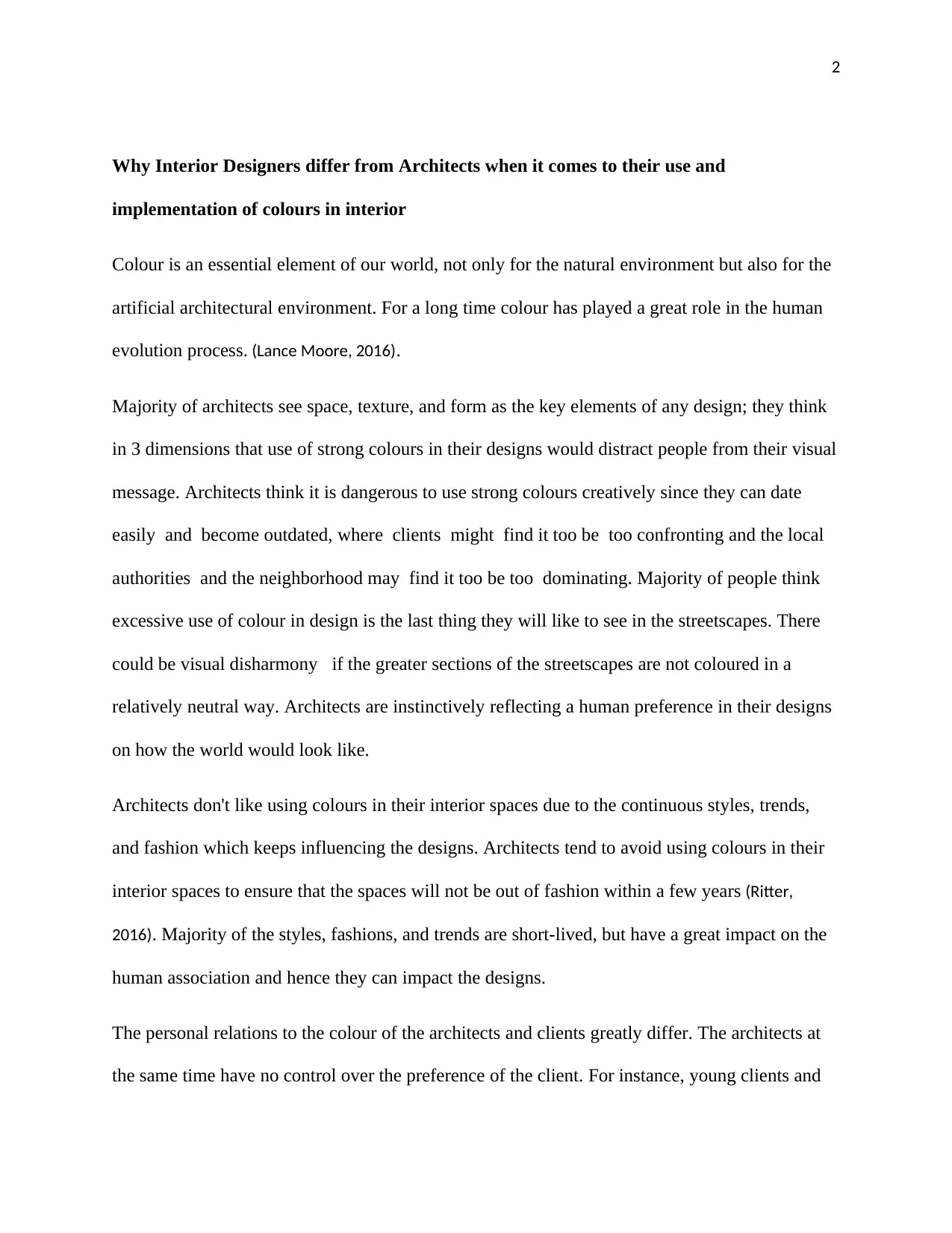
2
Why Interior Designers differ from Architects when it comes to their use and
implementation of colours in interior
Colour is an essential element of our world, not only for the natural environment but also for the
artificial architectural environment. For a long time colour has played a great role in the human
evolution process. (Lance Moore, 2016).
Majority of architects see space, texture, and form as the key elements of any design; they think
in 3 dimensions that use of strong colours in their designs would distract people from their visual
message. Architects think it is dangerous to use strong colours creatively since they can date
easily and become outdated, where clients might find it too be too confronting and the local
authorities and the neighborhood may find it too be too dominating. Majority of people think
excessive use of colour in design is the last thing they will like to see in the streetscapes. There
could be visual disharmony if the greater sections of the streetscapes are not coloured in a
relatively neutral way. Architects are instinctively reflecting a human preference in their designs
on how the world would look like.
Architects don't like using colours in their interior spaces due to the continuous styles, trends,
and fashion which keeps influencing the designs. Architects tend to avoid using colours in their
interior spaces to ensure that the spaces will not be out of fashion within a few years (Ritter,
2016). Majority of the styles, fashions, and trends are short-lived, but have a great impact on the
human association and hence they can impact the designs.
The personal relations to the colour of the architects and clients greatly differ. The architects at
the same time have no control over the preference of the client. For instance, young clients and
Why Interior Designers differ from Architects when it comes to their use and
implementation of colours in interior
Colour is an essential element of our world, not only for the natural environment but also for the
artificial architectural environment. For a long time colour has played a great role in the human
evolution process. (Lance Moore, 2016).
Majority of architects see space, texture, and form as the key elements of any design; they think
in 3 dimensions that use of strong colours in their designs would distract people from their visual
message. Architects think it is dangerous to use strong colours creatively since they can date
easily and become outdated, where clients might find it too be too confronting and the local
authorities and the neighborhood may find it too be too dominating. Majority of people think
excessive use of colour in design is the last thing they will like to see in the streetscapes. There
could be visual disharmony if the greater sections of the streetscapes are not coloured in a
relatively neutral way. Architects are instinctively reflecting a human preference in their designs
on how the world would look like.
Architects don't like using colours in their interior spaces due to the continuous styles, trends,
and fashion which keeps influencing the designs. Architects tend to avoid using colours in their
interior spaces to ensure that the spaces will not be out of fashion within a few years (Ritter,
2016). Majority of the styles, fashions, and trends are short-lived, but have a great impact on the
human association and hence they can impact the designs.
The personal relations to the colour of the architects and clients greatly differ. The architects at
the same time have no control over the preference of the client. For instance, young clients and
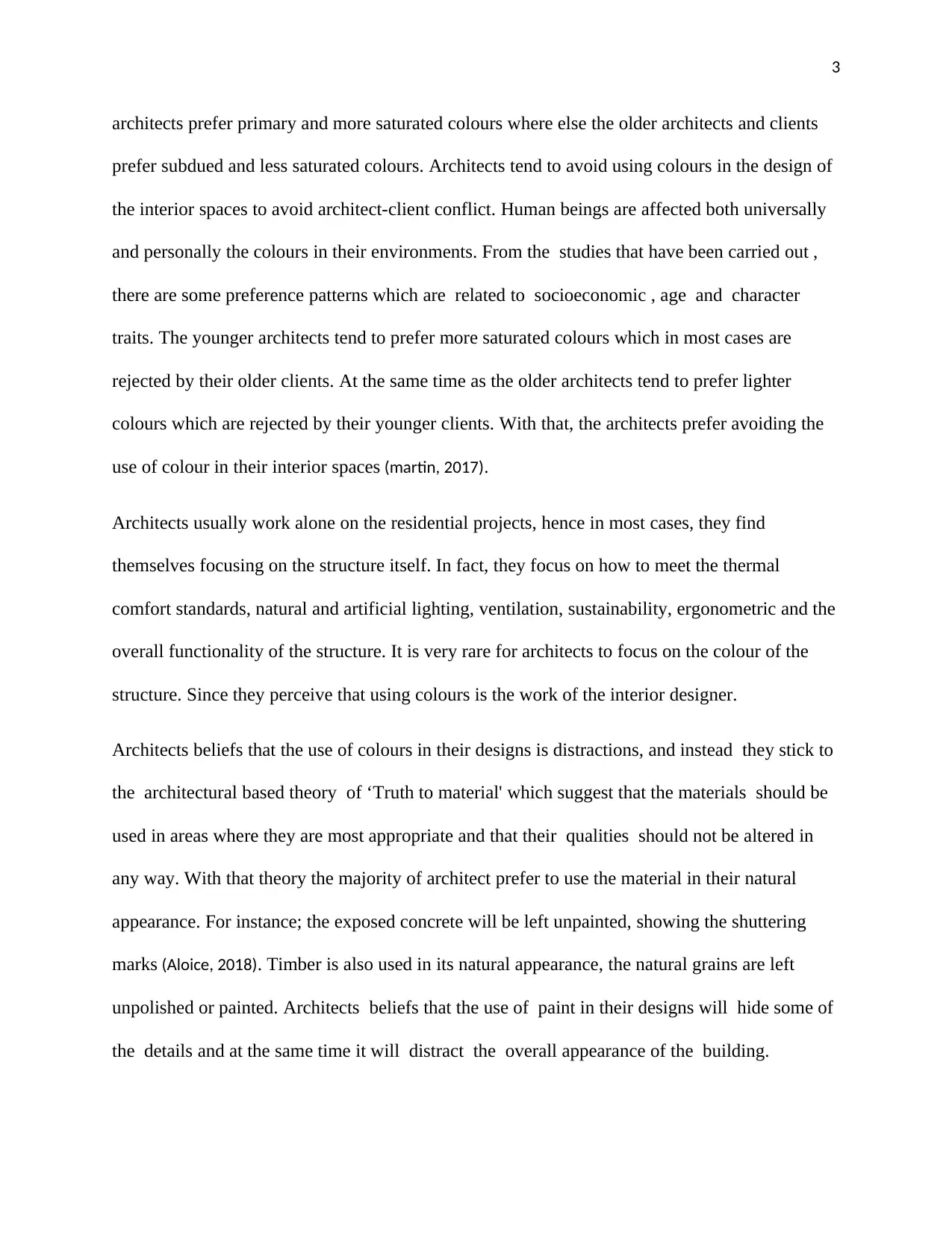
3
architects prefer primary and more saturated colours where else the older architects and clients
prefer subdued and less saturated colours. Architects tend to avoid using colours in the design of
the interior spaces to avoid architect-client conflict. Human beings are affected both universally
and personally the colours in their environments. From the studies that have been carried out ,
there are some preference patterns which are related to socioeconomic , age and character
traits. The younger architects tend to prefer more saturated colours which in most cases are
rejected by their older clients. At the same time as the older architects tend to prefer lighter
colours which are rejected by their younger clients. With that, the architects prefer avoiding the
use of colour in their interior spaces (martin, 2017).
Architects usually work alone on the residential projects, hence in most cases, they find
themselves focusing on the structure itself. In fact, they focus on how to meet the thermal
comfort standards, natural and artificial lighting, ventilation, sustainability, ergonometric and the
overall functionality of the structure. It is very rare for architects to focus on the colour of the
structure. Since they perceive that using colours is the work of the interior designer.
Architects beliefs that the use of colours in their designs is distractions, and instead they stick to
the architectural based theory of ‘Truth to material' which suggest that the materials should be
used in areas where they are most appropriate and that their qualities should not be altered in
any way. With that theory the majority of architect prefer to use the material in their natural
appearance. For instance; the exposed concrete will be left unpainted, showing the shuttering
marks (Aloice, 2018). Timber is also used in its natural appearance, the natural grains are left
unpolished or painted. Architects beliefs that the use of paint in their designs will hide some of
the details and at the same time it will distract the overall appearance of the building.
architects prefer primary and more saturated colours where else the older architects and clients
prefer subdued and less saturated colours. Architects tend to avoid using colours in the design of
the interior spaces to avoid architect-client conflict. Human beings are affected both universally
and personally the colours in their environments. From the studies that have been carried out ,
there are some preference patterns which are related to socioeconomic , age and character
traits. The younger architects tend to prefer more saturated colours which in most cases are
rejected by their older clients. At the same time as the older architects tend to prefer lighter
colours which are rejected by their younger clients. With that, the architects prefer avoiding the
use of colour in their interior spaces (martin, 2017).
Architects usually work alone on the residential projects, hence in most cases, they find
themselves focusing on the structure itself. In fact, they focus on how to meet the thermal
comfort standards, natural and artificial lighting, ventilation, sustainability, ergonometric and the
overall functionality of the structure. It is very rare for architects to focus on the colour of the
structure. Since they perceive that using colours is the work of the interior designer.
Architects beliefs that the use of colours in their designs is distractions, and instead they stick to
the architectural based theory of ‘Truth to material' which suggest that the materials should be
used in areas where they are most appropriate and that their qualities should not be altered in
any way. With that theory the majority of architect prefer to use the material in their natural
appearance. For instance; the exposed concrete will be left unpainted, showing the shuttering
marks (Aloice, 2018). Timber is also used in its natural appearance, the natural grains are left
unpolished or painted. Architects beliefs that the use of paint in their designs will hide some of
the details and at the same time it will distract the overall appearance of the building.
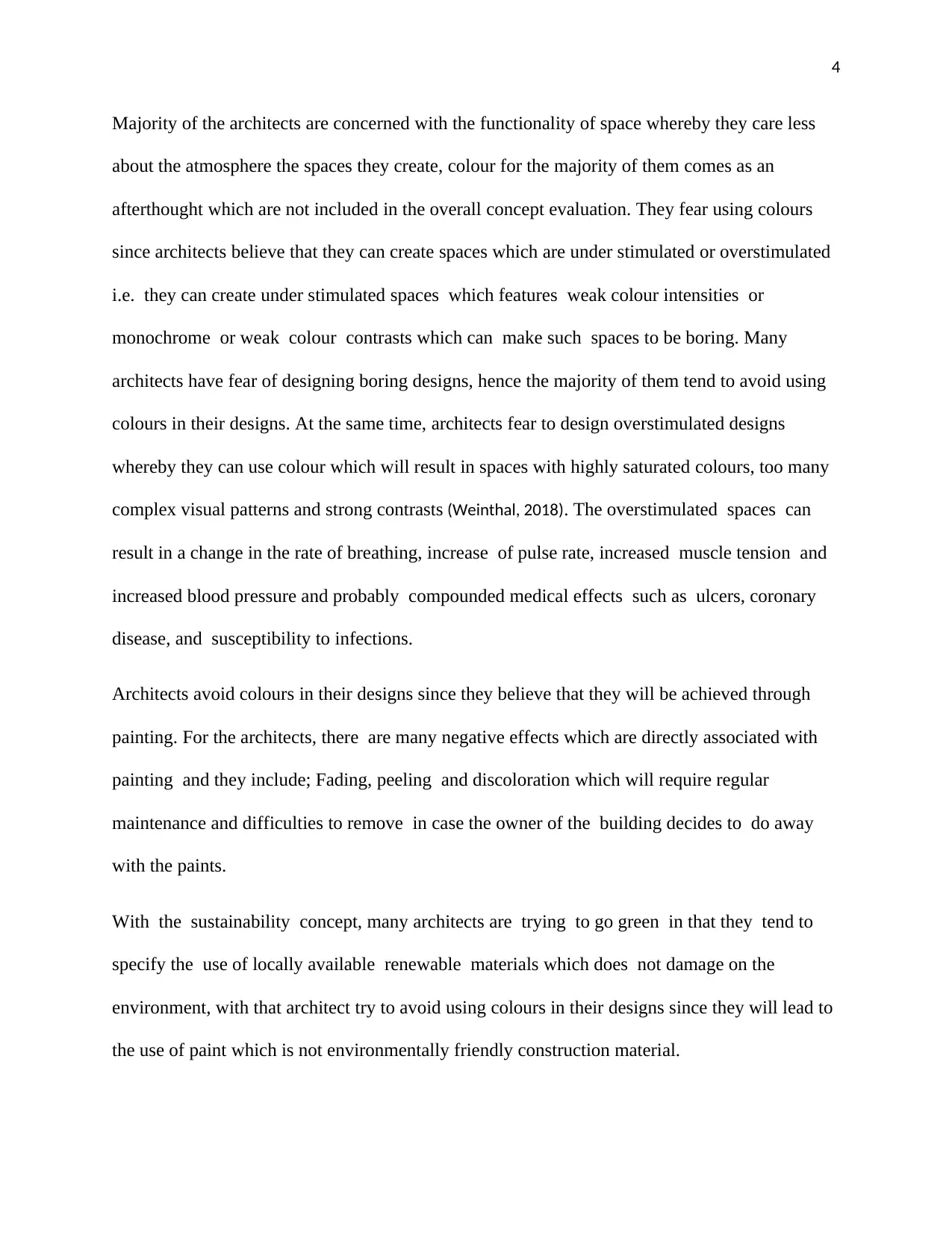
4
Majority of the architects are concerned with the functionality of space whereby they care less
about the atmosphere the spaces they create, colour for the majority of them comes as an
afterthought which are not included in the overall concept evaluation. They fear using colours
since architects believe that they can create spaces which are under stimulated or overstimulated
i.e. they can create under stimulated spaces which features weak colour intensities or
monochrome or weak colour contrasts which can make such spaces to be boring. Many
architects have fear of designing boring designs, hence the majority of them tend to avoid using
colours in their designs. At the same time, architects fear to design overstimulated designs
whereby they can use colour which will result in spaces with highly saturated colours, too many
complex visual patterns and strong contrasts (Weinthal, 2018). The overstimulated spaces can
result in a change in the rate of breathing, increase of pulse rate, increased muscle tension and
increased blood pressure and probably compounded medical effects such as ulcers, coronary
disease, and susceptibility to infections.
Architects avoid colours in their designs since they believe that they will be achieved through
painting. For the architects, there are many negative effects which are directly associated with
painting and they include; Fading, peeling and discoloration which will require regular
maintenance and difficulties to remove in case the owner of the building decides to do away
with the paints.
With the sustainability concept, many architects are trying to go green in that they tend to
specify the use of locally available renewable materials which does not damage on the
environment, with that architect try to avoid using colours in their designs since they will lead to
the use of paint which is not environmentally friendly construction material.
Majority of the architects are concerned with the functionality of space whereby they care less
about the atmosphere the spaces they create, colour for the majority of them comes as an
afterthought which are not included in the overall concept evaluation. They fear using colours
since architects believe that they can create spaces which are under stimulated or overstimulated
i.e. they can create under stimulated spaces which features weak colour intensities or
monochrome or weak colour contrasts which can make such spaces to be boring. Many
architects have fear of designing boring designs, hence the majority of them tend to avoid using
colours in their designs. At the same time, architects fear to design overstimulated designs
whereby they can use colour which will result in spaces with highly saturated colours, too many
complex visual patterns and strong contrasts (Weinthal, 2018). The overstimulated spaces can
result in a change in the rate of breathing, increase of pulse rate, increased muscle tension and
increased blood pressure and probably compounded medical effects such as ulcers, coronary
disease, and susceptibility to infections.
Architects avoid colours in their designs since they believe that they will be achieved through
painting. For the architects, there are many negative effects which are directly associated with
painting and they include; Fading, peeling and discoloration which will require regular
maintenance and difficulties to remove in case the owner of the building decides to do away
with the paints.
With the sustainability concept, many architects are trying to go green in that they tend to
specify the use of locally available renewable materials which does not damage on the
environment, with that architect try to avoid using colours in their designs since they will lead to
the use of paint which is not environmentally friendly construction material.
Secure Best Marks with AI Grader
Need help grading? Try our AI Grader for instant feedback on your assignments.
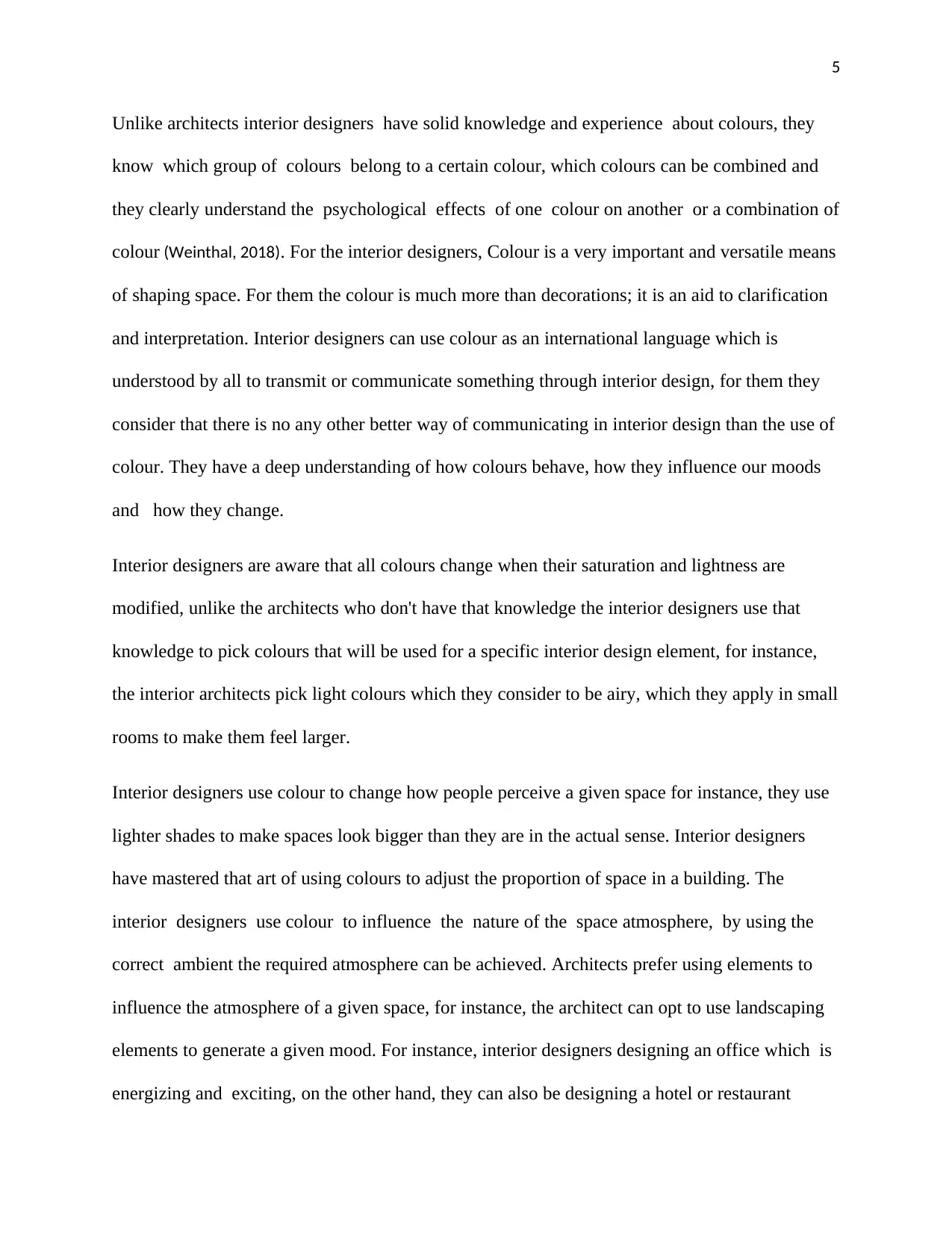
5
Unlike architects interior designers have solid knowledge and experience about colours, they
know which group of colours belong to a certain colour, which colours can be combined and
they clearly understand the psychological effects of one colour on another or a combination of
colour (Weinthal, 2018). For the interior designers, Colour is a very important and versatile means
of shaping space. For them the colour is much more than decorations; it is an aid to clarification
and interpretation. Interior designers can use colour as an international language which is
understood by all to transmit or communicate something through interior design, for them they
consider that there is no any other better way of communicating in interior design than the use of
colour. They have a deep understanding of how colours behave, how they influence our moods
and how they change.
Interior designers are aware that all colours change when their saturation and lightness are
modified, unlike the architects who don't have that knowledge the interior designers use that
knowledge to pick colours that will be used for a specific interior design element, for instance,
the interior architects pick light colours which they consider to be airy, which they apply in small
rooms to make them feel larger.
Interior designers use colour to change how people perceive a given space for instance, they use
lighter shades to make spaces look bigger than they are in the actual sense. Interior designers
have mastered that art of using colours to adjust the proportion of space in a building. The
interior designers use colour to influence the nature of the space atmosphere, by using the
correct ambient the required atmosphere can be achieved. Architects prefer using elements to
influence the atmosphere of a given space, for instance, the architect can opt to use landscaping
elements to generate a given mood. For instance, interior designers designing an office which is
energizing and exciting, on the other hand, they can also be designing a hotel or restaurant
Unlike architects interior designers have solid knowledge and experience about colours, they
know which group of colours belong to a certain colour, which colours can be combined and
they clearly understand the psychological effects of one colour on another or a combination of
colour (Weinthal, 2018). For the interior designers, Colour is a very important and versatile means
of shaping space. For them the colour is much more than decorations; it is an aid to clarification
and interpretation. Interior designers can use colour as an international language which is
understood by all to transmit or communicate something through interior design, for them they
consider that there is no any other better way of communicating in interior design than the use of
colour. They have a deep understanding of how colours behave, how they influence our moods
and how they change.
Interior designers are aware that all colours change when their saturation and lightness are
modified, unlike the architects who don't have that knowledge the interior designers use that
knowledge to pick colours that will be used for a specific interior design element, for instance,
the interior architects pick light colours which they consider to be airy, which they apply in small
rooms to make them feel larger.
Interior designers use colour to change how people perceive a given space for instance, they use
lighter shades to make spaces look bigger than they are in the actual sense. Interior designers
have mastered that art of using colours to adjust the proportion of space in a building. The
interior designers use colour to influence the nature of the space atmosphere, by using the
correct ambient the required atmosphere can be achieved. Architects prefer using elements to
influence the atmosphere of a given space, for instance, the architect can opt to use landscaping
elements to generate a given mood. For instance, interior designers designing an office which is
energizing and exciting, on the other hand, they can also be designing a hotel or restaurant
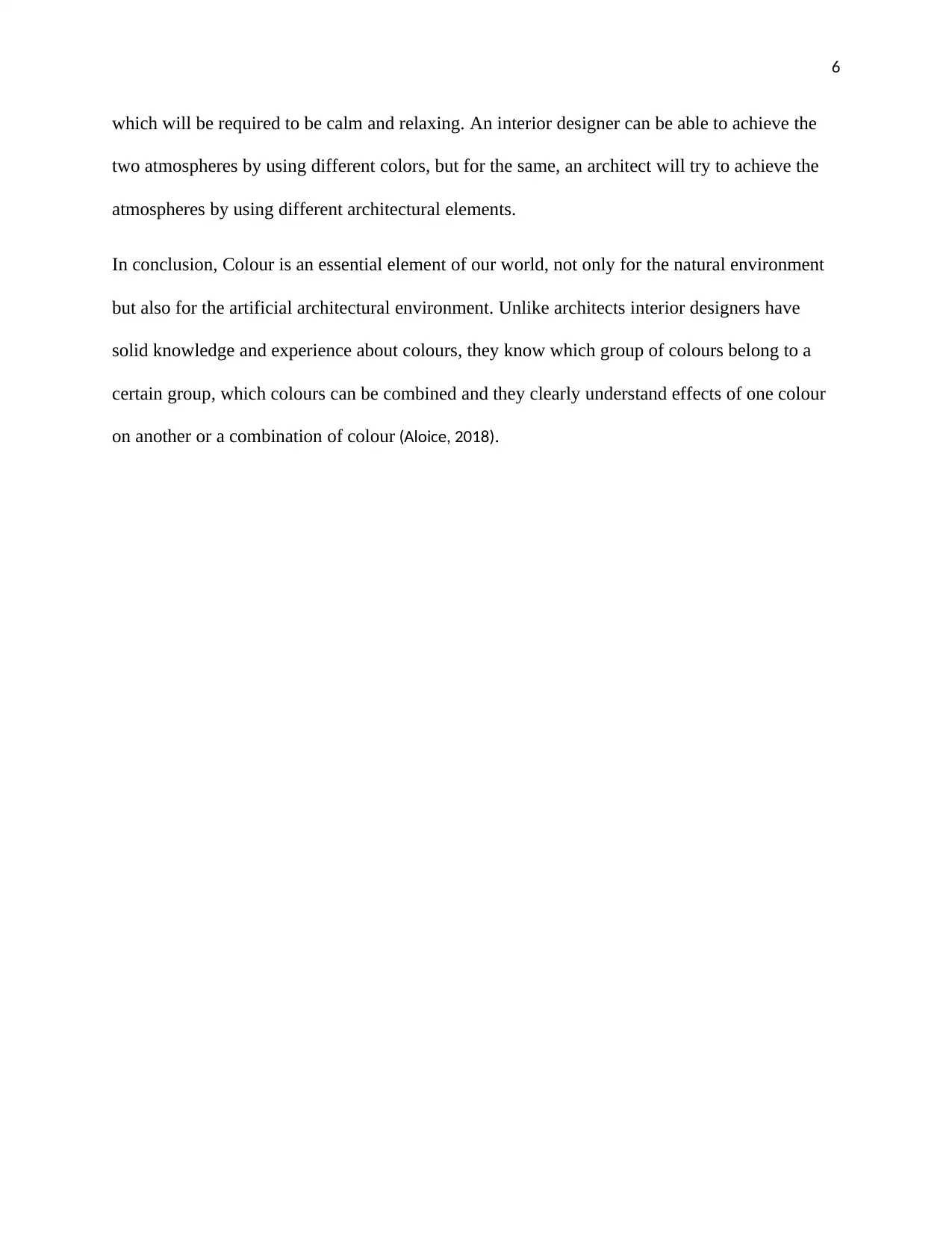
6
which will be required to be calm and relaxing. An interior designer can be able to achieve the
two atmospheres by using different colors, but for the same, an architect will try to achieve the
atmospheres by using different architectural elements.
In conclusion, Colour is an essential element of our world, not only for the natural environment
but also for the artificial architectural environment. Unlike architects interior designers have
solid knowledge and experience about colours, they know which group of colours belong to a
certain group, which colours can be combined and they clearly understand effects of one colour
on another or a combination of colour (Aloice, 2018).
which will be required to be calm and relaxing. An interior designer can be able to achieve the
two atmospheres by using different colors, but for the same, an architect will try to achieve the
atmospheres by using different architectural elements.
In conclusion, Colour is an essential element of our world, not only for the natural environment
but also for the artificial architectural environment. Unlike architects interior designers have
solid knowledge and experience about colours, they know which group of colours belong to a
certain group, which colours can be combined and they clearly understand effects of one colour
on another or a combination of colour (Aloice, 2018).
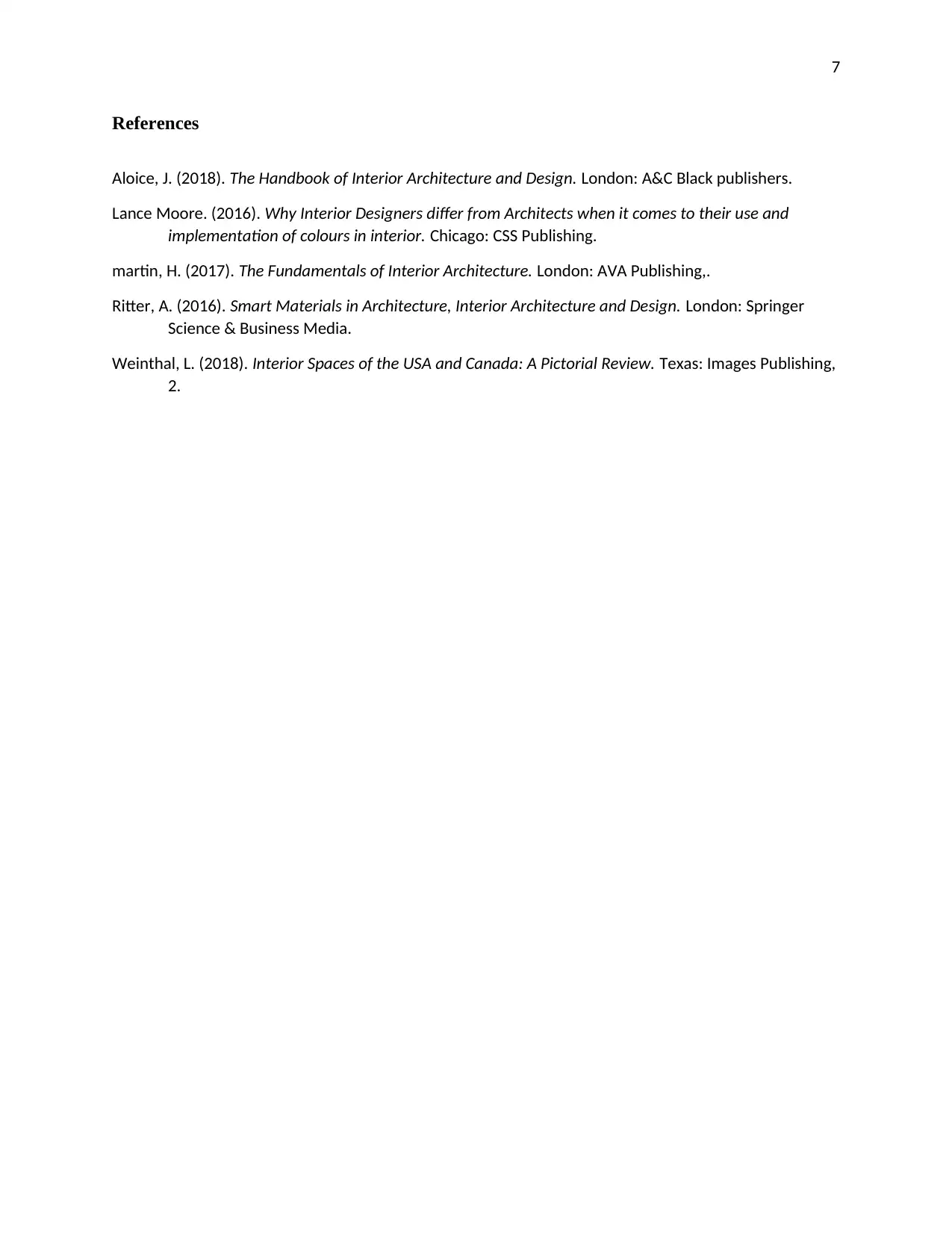
7
References
Aloice, J. (2018). The Handbook of Interior Architecture and Design. London: A&C Black publishers.
Lance Moore. (2016). Why Interior Designers differ from Architects when it comes to their use and
implementation of colours in interior. Chicago: CSS Publishing.
martin, H. (2017). The Fundamentals of Interior Architecture. London: AVA Publishing,.
Ritter, A. (2016). Smart Materials in Architecture, Interior Architecture and Design. London: Springer
Science & Business Media.
Weinthal, L. (2018). Interior Spaces of the USA and Canada: A Pictorial Review. Texas: Images Publishing,
2.
References
Aloice, J. (2018). The Handbook of Interior Architecture and Design. London: A&C Black publishers.
Lance Moore. (2016). Why Interior Designers differ from Architects when it comes to their use and
implementation of colours in interior. Chicago: CSS Publishing.
martin, H. (2017). The Fundamentals of Interior Architecture. London: AVA Publishing,.
Ritter, A. (2016). Smart Materials in Architecture, Interior Architecture and Design. London: Springer
Science & Business Media.
Weinthal, L. (2018). Interior Spaces of the USA and Canada: A Pictorial Review. Texas: Images Publishing,
2.
1 out of 7
Your All-in-One AI-Powered Toolkit for Academic Success.
+13062052269
info@desklib.com
Available 24*7 on WhatsApp / Email
![[object Object]](/_next/static/media/star-bottom.7253800d.svg)
Unlock your academic potential
© 2024 | Zucol Services PVT LTD | All rights reserved.